To clean and restore your oven rack or grill, start by gathering essential supplies like rubber gloves, a grill brush, and either commercial cleaners (like Carbona 2-in-1 or Goo Gone) or natural solutions (vinegar and baking soda mixture). You'll want to soak the racks in warm, soapy water overnight using a large plastic bag or bucket for best results. After soaking, scrub gently with a brush to remove buildup, then rinse thoroughly and dry completely. For stubborn grease, try making a paste with baking soda and water. To prevent future buildup and extend your rack's life, regular maintenance and proper storage are key elements you'll want to master.
Essential Cleaning Supplies
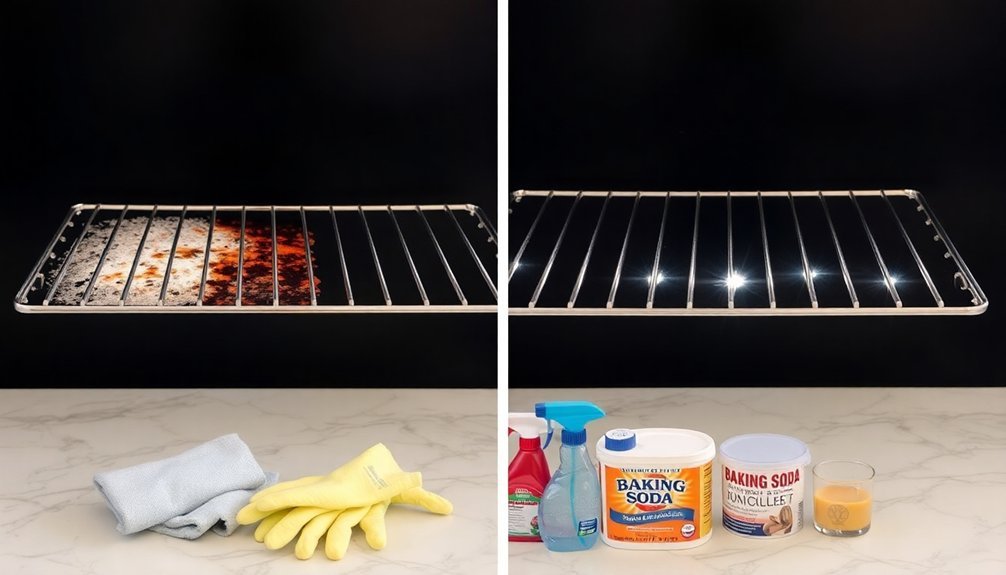
When tackling the task of cleaning your oven rack and grill, you'll need the right combination of cleaning solutions and tools.
Choose from proven cleaners like Carbona 2-in-1, Goo Gone, or Essential Oven & Grill Cleaner, or make your own solution using vinegar, baking soda, and water.
You'll want to gather essential tools including a grill brush or scraper for stubborn residue, a scrubbing brush for thorough cleaning, and a microfiber cloth for final wiping.
Don't forget protective gear like rubber gloves and optional eyewear.
For soaking, you'll need either an extra-large plastic bag or a bucket filled with warm, soapy water. The most effective results come from overnight soaking to achieve a like-new shine.
Keep a plastic or metal scraper handy for removing tough, baked-on grime, and ambient water nearby for rinsing surfaces after cleaning.
Safety Precautions While Cleaning
Before diving into oven rack cleaning, understanding proper safety measures will protect both you and your appliance. Never leave your racks in during self-cleaning cycles, as extreme temperatures can warp and damage them. Instead, opt for gentler cleaning methods at room temperature.
You'll want to avoid harsh chemical cleaners that release toxic fumes. Choose eco-friendly alternatives like baking soda and vinegar solutions instead.
When cleaning, work in a well-ventilated area and always wear protective gloves. Don't use abrasive materials like steel wool that can scratch your racks and oven surfaces. Krud Kutter or Weiman are safer cleaning alternatives.
Remember to remove excess grease regularly to prevent fire hazards, and verify your stovetop is completely cool before starting.
After cleaning, thoroughly dry your racks to prevent water spots and rust formation, especially if they're made of cast iron.
Soaking Methods for Solar Racks
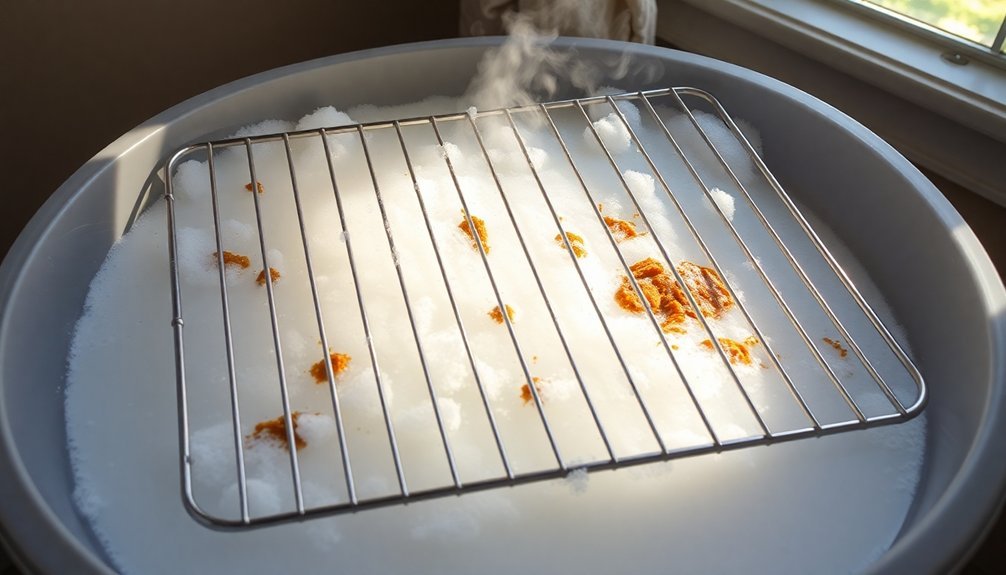
To effectively clean your solar oven racks, several proven soaking methods can dissolve stubborn grease and grime while minimizing scrubbing effort.
You'll find success using the baking soda and vinegar method, where you'll combine these ingredients in hot water for an 8-12 hour soak.
Another option is using dish soap in hot water for 2-4 hours, followed by a gentle scrub with a soft brush.
If you're dealing with particularly tough buildup, try the dishwasher detergent method – just protect your tub with old towels first and soak overnight.
For a gentler approach, you can use dryer sheets in warm water, letting them soak for several hours before using the sheets themselves as cleaning aids.
Remember to rinse thoroughly and dry completely after any soaking method.
Professional cleaning services can tackle especially difficult cases when DIY methods aren't sufficient.
Outdoor Cleaning Techniques
You'll find outdoor cleaning more manageable by starting with a thorough garden hose rinse to loosen dirt and debris.
For a quick driveway scrub, connect a rotating brush attachment to your garden hose and work in small, overlapping sections.
Work your way from the highest point of the driveway down to guarantee runoff doesn't flow over already cleaned areas.
Garden Hose Deep Clean
When tackling outdoor cleaning projects, a garden hose with a high-pressure nozzle becomes your most versatile tool for deep cleaning various surfaces. You'll need to verify your hose is properly maintained for peak cleaning performance.
Start by attaching a high-pressure nozzle to blast away stubborn dirt from driveways, siding, and walkways. For the best results, combine your hose cleaning with a surface-appropriate cleaning solution and soft-bristled brush to remove tough grime.
Don't forget to clean the hose itself regularly – soak it in a bleach-water mixture or white vinegar solution for 8-24 hours every 3-4 months. After each use, drain excess water and store your hose in a dry place.
Remember to thoroughly rinse the nozzle and fittings with warm water and mild soap to maintain proper function.
Quick Driveway Scrub Session
While maintaining your driveway's appearance requires regular upkeep, a quick scrub session can effectively remove dirt, stains, and unsightly buildup. Start by clearing debris and sweeping the surface thoroughly. Pre-treat stubborn spots with a degreaser, letting it sit for 10-15 minutes.
| Task | Tool | Duration |
|---|---|---|
| Pre-treat | Degreaser | 15 min |
| Scrub | Nylon brush | 10 min |
| Rinse | Garden hose | 5 min |
For the best results, work in small sections using a stiff-bristled brush dipped in hot, soapy water. You'll want to maintain a 25-degree angle when pressure washing, moving systematically from high to low areas. For oil stains, apply absorbents like cat litter before cleaning. Finally, rinse thoroughly with clean water to remove all cleaning solutions and guarantee a spotless finish.
Natural Cleaning Solutions

You'll find natural cleaning solutions highly effective for tackling grimy oven racks, with vinegar and baking soda creating a powerful fizzing action that breaks down stubborn grease.
Orange oil mixed into a paste offers a citrus-based alternative that cuts through baked-on residue while leaving a fresh scent.
For an eco-friendly approach, gentle plant-based soap solutions work well when combined with an overnight soak, protecting both your racks and the environment.
Vinegar Baking Soda Mix
Natural cleaning solutions offer a safe and effective way to tackle stubborn oven rack grime, with baking soda and vinegar leading the charge.
You'll want to start by spraying your oven racks with distilled white vinegar, then sprinkle baking soda evenly across all surfaces. Watch as the mixture creates a powerful foaming reaction that helps break down tough residues.
- Spray both sides of the racks thoroughly with white vinegar
- Cover all surfaces with an even layer of dry baking soda
- Let the foaming reaction work its magic
- Prepare for the overnight soak in hot water
Once the foaming subsides, submerge your racks in hot water for 8-10 hours. This extended soak allows the cleaning mixture to penetrate and loosen years of built-up grime, making the final scrubbing process much easier.
Orange Oil Natural Paste
Another potent cleaning solution combines the power of orange essential oil with familiar household ingredients to create an effective cleaning paste. You'll need to mix ¾ cup baking soda with 15 drops of orange essential oil and 3-5 tablespoons of water until you achieve a thick consistency.
| Ingredient | Amount | Benefits |
|---|---|---|
| Baking Soda | ¾ cup | Natural abrasive |
| Orange Oil | 15 drops | Breaks down grease |
| Water | 3-5 tbsp | Creates paste texture |
Apply this paste generously to your oven racks using a damp sponge, then let it sit for 6-8 hours or overnight. You can enhance the cleaning power by adding pine or tea tree oil. After the waiting period, scrub the racks gently with a kitchen scrubber, using salt for stubborn spots. Rinse thoroughly and dry completely before reinstalling.
Eco-Friendly Soap Solutions
Several eco-friendly soap solutions offer powerful yet gentle cleaning alternatives for restoring oven racks to their original shine.
You'll find these natural methods equally effective as harsh chemical cleaners, while being safer for your home and the environment.
- Create a paste using baking soda and Sal Suds, then let it work its magic for 30 minutes before scrubbing.
- Mix a DIY sugar soap solution with brown sugar, almond oil, and natural body wash for a fragrant cleaning option.
- Combine baking soda with dish soap in a hot water bath, soaking racks overnight for effortless cleaning.
- Use a simple baking soda and water solution for an overnight soak, followed by gentle wiping with a sponge.
These methods work best when you allow sufficient soaking time, letting the natural ingredients break down stubborn grease and grime.
Commercial Cleaners for Racks
Professional-grade commercial cleaners offer powerful solutions for restoring grimy oven racks and grill grates to their original shine.
You'll find several effective options on the market, each with unique benefits. Carbona 2-in-1 uses an odor-free formula that works over 8 hours in a sealed bag, while Easy-Off Heavy Duty tackles tough stains in just 40 minutes on multiple surfaces. For quick results, try Goo Gone's biodegradable foam that works in 3-5 minutes.
When using these cleaners, you'll need to follow specific safety protocols. Always work in well-ventilated areas, wear protective gloves, and keep children away from cleaning supplies.
Remember to check surface compatibility – while Easy-Off works on most materials, Mr. Clean Magic Eraser isn't suitable for stainless steel or nonstick coatings.
Maintaining Solar Rack Performance

You'll need to create a consistent cleaning schedule for your solar racks, focusing on removing dirt and debris that can impact their performance.
Check your system's mounting hardware and electrical connections monthly, looking for signs of corrosion, loose components, or wear that could affect energy production.
Regular monitoring of your system's output will help you spot potential issues early, allowing you to address problems before they become serious maintenance concerns.
Regular Cleaning Schedule
Maintaining peak performance of your solar panel system requires a structured cleaning schedule that spans weekly, monthly, quarterly, and annual intervals.
You'll need to follow specific tasks at each interval to guarantee ideal energy production and system longevity.
- Weekly tasks focus on visual inspections and debris removal using a leaf blower, along with monitoring system output against typical values.
- Monthly maintenance includes deep cleaning with soft brushes and water, checking mounts and wiring, and recording inverter readings.
- Quarterly checks involve roof inspections, panel angle adjustments, and thorough debris removal from panels.
- Annual and biannual maintenance requires professional system inspections every 2-3 years, warranty reviews, and meticulous cleaning to remove accumulated dirt and bird droppings.
Remember to document all maintenance activities and track system performance data consistently.
Performance Inspection Steps
To guarantee ideal solar panel performance, regular inspection steps must follow a systematic approach covering four key areas: visual panel examination, electrical system checks, performance testing, and structural evaluation.
Start by examining each panel's surface for cracks, debris, or discoloration that could reduce efficiency. You'll need to verify secure mounting and check for any shading issues from nearby vegetation.
Next, inspect all electrical connections, wiring, and the inverter for wear, ensuring there aren't any loose or exposed wires.
Use a multimeter to measure power output and conduct I-V curve testing to verify system efficiency is within 5% of STC power.
Finally, assess the structural integrity of your racking system by checking for rust, loose bolts, or damaged brackets. Don't forget to trim any overhanging branches that may cast shadows on your panels.
Preventing Rust and Corrosion
Protecting your oven rack and grill grates from rust and corrosion requires a combination of proper maintenance and preventive measures.
You'll want to focus on using protective coatings, selecting rust-resistant materials, and performing regular cleaning routines to extend the life of your cooking equipment.
- Apply a thin layer of vegetable oil or melted animal fat after each cleaning to create a protective barrier against moisture.
- Choose racks made from stainless steel or powder-coated materials rather than carbon steel or untreated iron.
- Clean your racks with mild detergents, avoiding harsh chemicals and abrasive materials that can damage protective surfaces.
- Dry thoroughly after washing and store in a low-humidity environment.
For stubborn rust spots, you can use a wire brush or polycarbide wheel to remove corrosion, then immediately treat the exposed metal with a protective coating to prevent future oxidation.
Storage Between Cooking Sessions
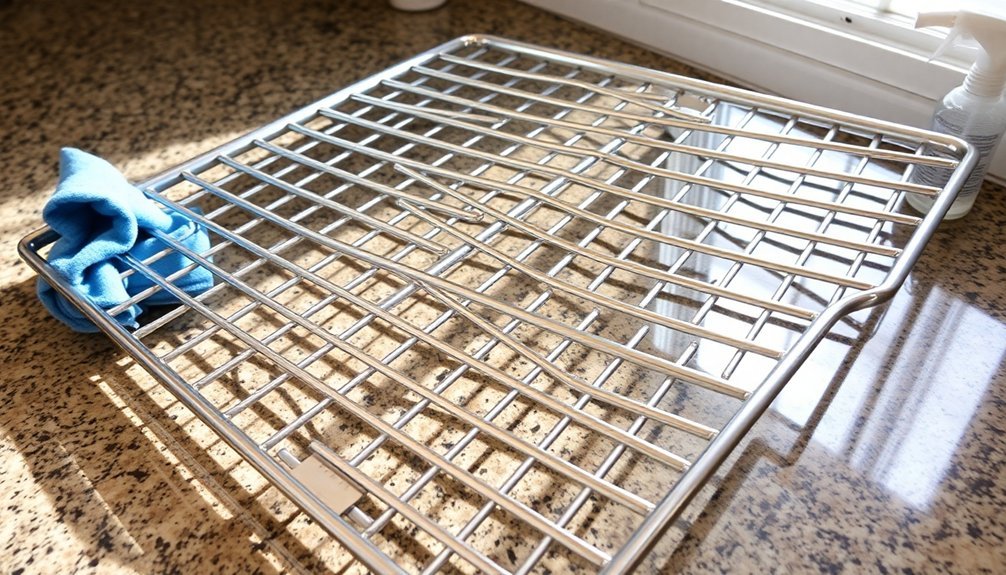
Proper storage between cooking sessions plays an essential role in extending the life of your grill racks and tools.
You'll want to protect your equipment from the elements by storing them indoors whenever possible, using cabinets or shelves for your grilling essentials.
If you've got outdoor storage needs, invest in weather-resistant cabinets or a grill cart with built-in compartments.
These provide excellent organization while keeping your tools easily accessible. For maximum convenience, choose storage solutions with wheels so you can move your equipment as needed.
Don't forget to use hooks and utensil holders to keep your spatulas, brushes, and tongs organized.
Consider using storage cases with specialized compartments for delicate tools, and label your storage areas to quickly find what you need when it's time to fire up the grill.
Rack Inspection Guidelines
Regular inspection of your oven racks serves as a critical safeguard against potential cooking hazards and performance issues. Before each cleaning session, thoroughly examine your racks for signs of wear, damage, or corrosion that might affect their functionality.
You'll want to focus on areas where food and grease tend to accumulate, as these spots can impact both cooking performance and food safety.
- Check for warping or distortion that could prevent even cooking or proper rack placement.
- Look for heavy staining or discoloration that might indicate deep-set damage.
- Examine the rack's surface for rust, corrosion, or deterioration.
- Test the rack's stability and positioning to guarantee secure placement in the oven.
If you spot any significant issues during inspection, consider replacing the racks to maintain ideal cooking results and safety.
Extending Rack Lifespan
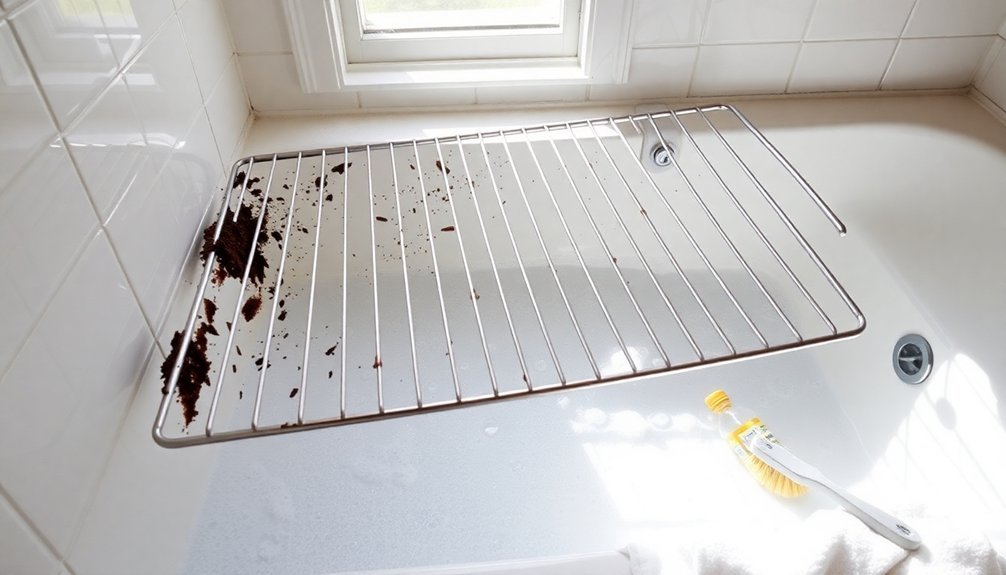
After identifying potential issues during inspection, implementing smart maintenance practices can greatly extend your oven rack's service life. You'll want to clean your racks after each use and schedule deep cleaning quarterly to prevent stubborn buildup. Use mild detergent solutions and avoid harsh chemicals that can damage the surface.
| Action | Benefit |
|---|---|
| Daily wiping | Prevents grease accumulation |
| Gentle cleaning tools | Preserves surface integrity |
| Baking soda paste | Natural, non-damaging solution |
| Proper storage | Reduces rust formation |
| Regular maintenance | Extends lifespan |
Don't use abrasive materials like steel wool or wire brushes that can scratch the surface. When dealing with tough grime, opt for non-abrasive scrubbers or an old toothbrush. Always wear protective gear when using cleaning solutions, and guarantee the racks are cool before cleaning.
Frequently Asked Questions
How Often Should I Deep Clean My Oven Racks?
You should deep clean your oven racks every 3-4 months with average use. If you're a frequent baker or cook, clean them more often. Wipe down racks after each use to prevent heavy buildup.
Can I Clean Multiple Oven Racks in the Bathtub Simultaneously?
Yes, you can clean multiple oven racks in the bathtub at once. Just guarantee there's enough space for them to lie flat without overlapping, and make sure they're fully submerged in the cleaning solution.
Will Cleaning Products Affect the Taste of Food Cooked Later?
Yes, if you don't rinse thoroughly, cleaning product residues can affect your food's taste and safety. You'll want to guarantee you've completely removed all chemical traces before cooking to avoid any unpleasant flavors or health risks.
Are Self-Cleaning Ovens Safe for Chrome-Plated Racks?
While you can use self-cleaning ovens with chrome-plated racks, it's not recommended. The high heat will permanently discolor your racks from shiny chrome to dull grey and may affect their smooth sliding functionality.
What's the Fastest Way to Remove Burnt Sugar From Oven Racks?
You'll get the quickest results using Method 4: spray a hot vinegar-baking soda solution directly on burnt sugar while the oven's still warm, then scrape it off with a spatula after brief soaking.
In Summary
You'll find that regular maintenance of your oven rack grill isn't just about cleanliness – it's an investment in your cooking equipment's longevity. By following proper cleaning techniques, using natural solutions when possible, and storing your racks correctly, you're protecting them from rust and ensuring consistent cooking performance. Don't skip routine inspections, and you'll enjoy reliable, well-maintained racks for years to come.

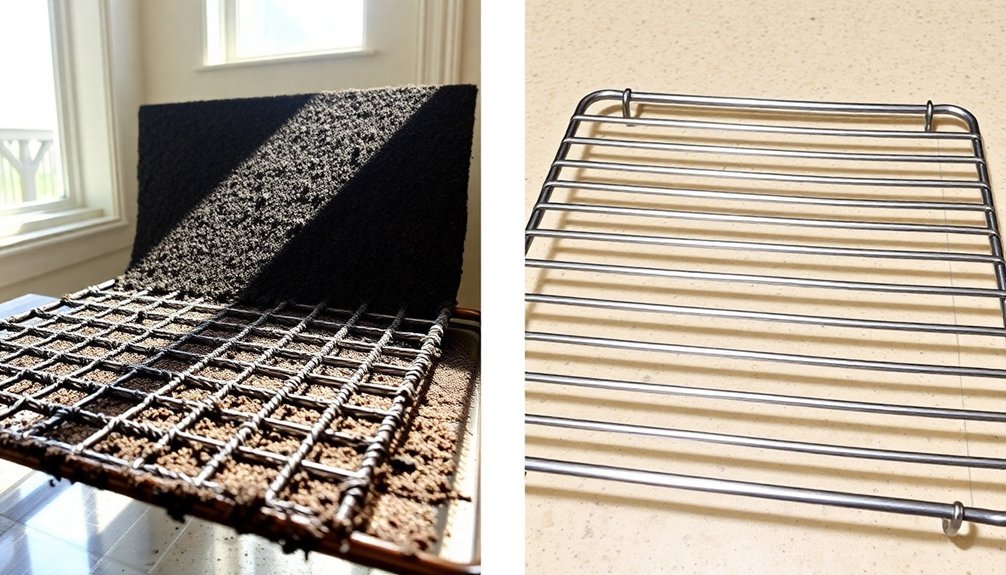
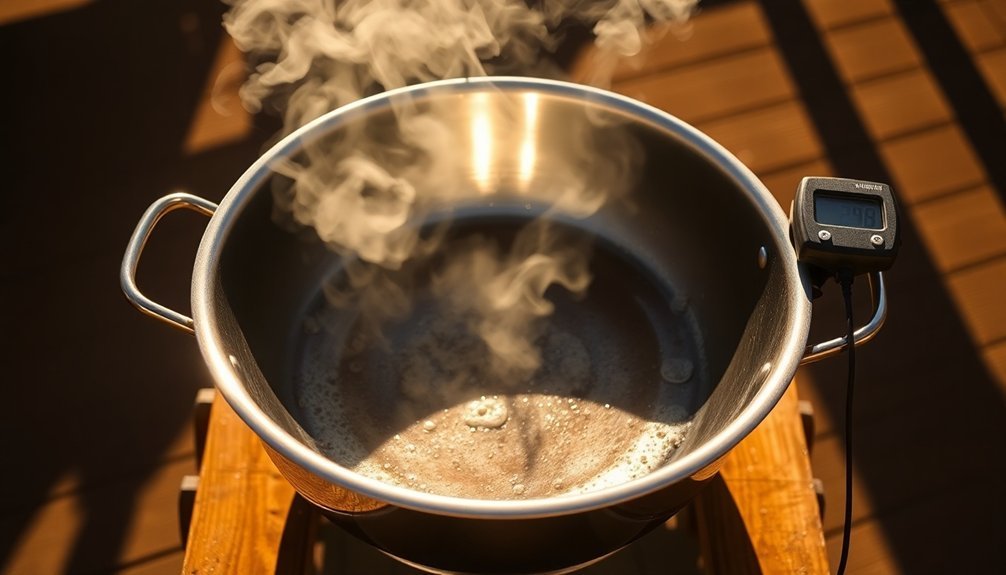
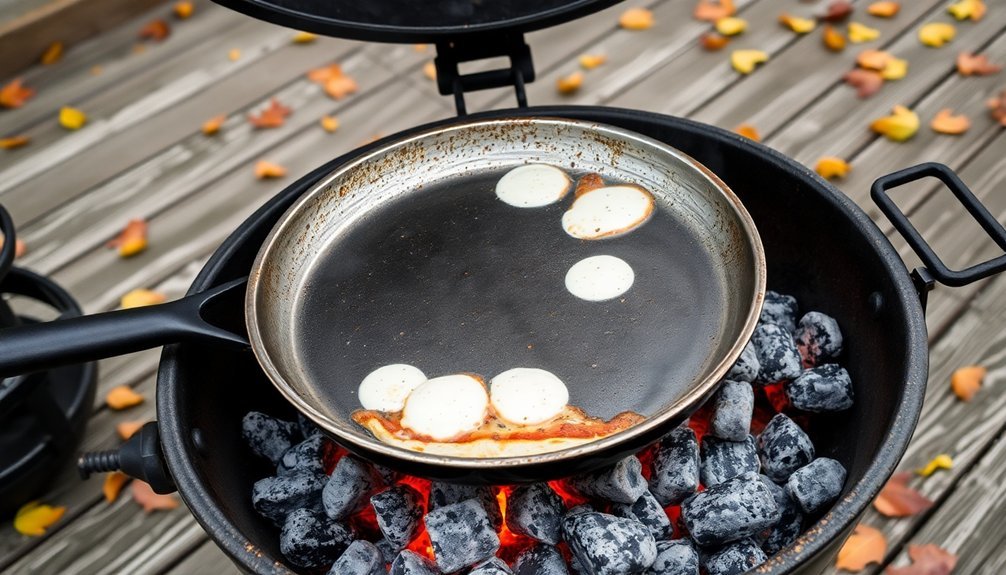
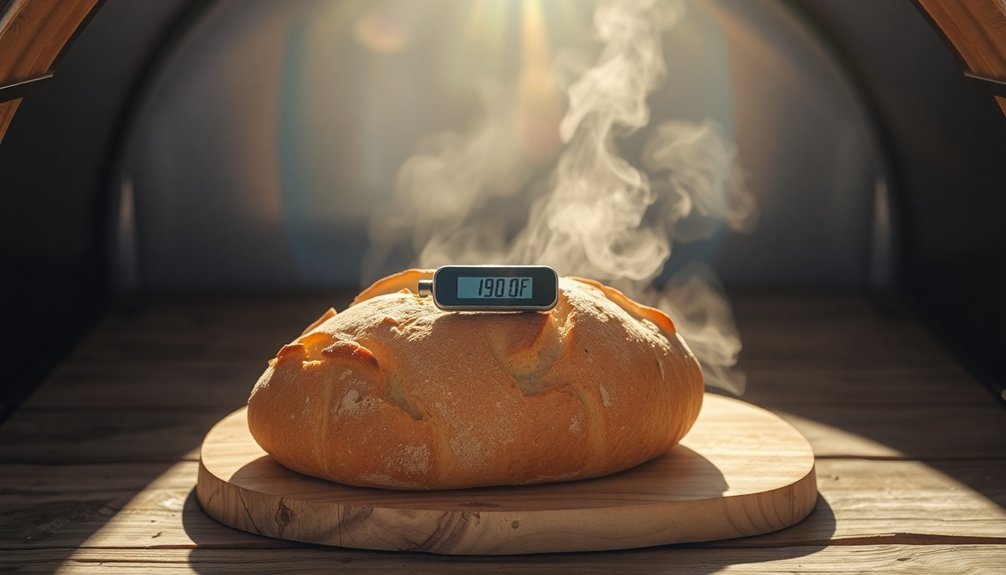
Leave a Reply